
|   |

|   |
The 23rd OMC Guru Kelucharan Mohapatra Award Festival - Lalitha Venkat e-mail: lalvenkat@yahoo.com Photos courtesy: Srjan September 13, 2017 The 23rd edition of Srjan's OMC Guru Kelucharan Mohapatra Award Festival (Odisha Mining Corporation is the festival's title sponsor this year) took place from September 5 to 9, 2017 at Rabindra Mandap, Bhubaneswar. Since the Chief Minister Naveen Patnaik could not make it to the closing award function, he put in a brief ten minute appearance to inaugurate the festival. The festival took off to a flying start with 'Ekatatva' conceptualized, choreographed and performed by the three Mumbai based exponents Daksha Mashruwala (Odissi), Uma Dogra (Kathak) and Vaibhav Arekar (Bharatanatyam). The underlying idea is, "When the body, mind and soul unite, samaadhi is achieved. Ekatatva is about this samaadhi, about celebrating the body and its movement as a medium to reach beyond the plane of this mundane existence." The English narrative in intervals helped to enlighten the audience on each segment, though the introduction was rather long with the stage in darkness. Beginning with salutation to the elements in nature, the worship of nature gods by mankind was followed by worship of newly developed iconographic gods. While all these give happiness at different stages, it is ultimately the happiness of the inner self that gives spiritual bliss - it could be the sun, moon and the stars…or the animals and birds…one can see god in anything leading to that inner spiritual fulfillment. The finale ended in a sufi style whirling tastefully done with flowing white dupatta draped on the arms looking like wings. Ekatatva was developed from an initially short item by Daksha and Uma Dogra to a full length production with the three artistes. The search for the truth via solo abhinaya pieces that leads to realization had to be edited out for this presentation, so the continuity suffered with the intended idea not coming through and the last part seemed to be a happy dance with nritta in the three dance styles ending in spiritual fulfillment in the sufi movements. The costumes changes and colors were suitably adapted for the edited version. Two sari panels at the back and two in the front formed the props for the dancers to weave their movements around. The wonderful music direction by Manoj Desai and excellent light execution by Debiprasad Mishra enhanced the graceful dance movements. How did dancers of different styles coordinate to bring about a balanced presentation? "It was at rehearsal that we looked at a concept that can lend and at the same time accommodate different dynamics of each style. We had to work more with movements of nritta especially. We had to find out which movements kinetically blend with each other. It is challenging to find that equilibrium in choreography where sometimes one style has to compliment the other style, at times underline the difference in kinetica and at times completely merge into the other. The final texture of movement that the choreographers arrive at happens in the process that takes place inside the studio space - where one constantly keeps working and reworking on the choreography," says Vaibhav Arekar. In the 23 years of the festival, Uma Dogra has performed thrice in solo evenings and this was her first group performance at the festival.
Annada Prasanna Pattanaik on flute and Pushpa Kashinath on the veena presented a jugalbandhi accompanied by Udayaraj Karpur on tabla in a pleasant music session that included classical ragas, Odiya folk tunes and even a fusion number composed by Annada that received a rapturous response. Though one wished Pushpa had played more - she somehow seemed a bit unsure - her deft matching of the flute notes (when she did play) and Karpur's accompaniment especially in the fusion number were appreciated by the audience. The second evening witnessed an elegant solo Bharatanatyam performance by Navia Natarajan who divides her time between US and Bangalore. She presented two items choreographed by her, accompanied by Nandini Sharma on vocal, Vedakrishnaram on mridangam, Balakrishnan on nattuvangam, and Kalaiarasan on violin. Clad in a red costume with gold border and a gold color blouse, Navia looked quite resplendant as she faced the audience in the seated muzhumandi position, the fan of her costume spread out, the light from above shining down on her. 'Parashakti' (Ragamalika, adi) was an ode to the Devi, the feminine principle of creation. Navia's evocative movements and choreography uncovered the many faces of the divine goddess, compassionate and fierce, loving and wrathful, creative and destructive. Music composition is by Debur Srivatsa. As an emerging choreographer, what challenges did Navia face? "For me, choreography is more about being a roller coaster ride; it is extremely exhilarating when I start to conceptualize and compose a piece, like Parashakti. I had actually witnessed Durga pooja and at that point I wondered what was pulling me towards the form of Durga. I could see beauty on the one side and ferocity on the other. I wanted to juxtapose the two. So I discussed with my resource person Dr. Shankar and he helped me with the verses. The verses taken from Navarathnamalika sthothram of Adi Shankaracharya shows the beauty of her nature and from Lalithopakyanam by Soma Deva Sharma shows her wrathful side. I tried to draw parallels within that, how we invoke the auspicious energy within us to annihilate the evil. I personalized it at the end," says Navia. The varnam "Swami naan undhan adimai" (Nattukurinji, adi) depicted a heroine's passion and devotion for Lord Shiva. In her unabashed declaration of love, she seeks to unite with him, in this composition by Papanasam Sivan, with rhythmic composition by DV Prasanna Kumar. Perfect measured movements of nritta and restrained abhinaya morphed seamlessly into a beautiful evening of Bharatanatyam. Nothing was overdone, no distorted ferocity of the goddess in the first ítem or exaggerated pining of the nayika in the varnam. The jathis were also quite interesting in sound and in movement patterns. With Nandini's soulful singing and a supportive orchestra, the team deservedly got repeated applause. Jaydev Das was his usual best at the lights. So what was different in Navia's version of the popular varnam? "In the varnam, the fourth line speaks about the ananda natanam of Nataraja. The nayika says she wants to have a glimpse of his dancing feet. For that, I went through a couple of books. One of them had certain sollukettus pertaining to ananda natanam. I discussed with nattuvanar Prasanna Kumar on how to frame the jathis to be apt for the particular line and he came up with this. In the varnam, I have tried to see what resonates with me. I felt each line resonate in a different way. That is why the choreography is also personalized. Usually dancers use stories from mythology and I also love to work on such stories, but in this particular varnam, I felt I should do what resonates with me. That's when it became personalized." How does Navia view choreographic challenges? "When I have a piece in hand, I have to understand what the poet is trying to say and how do I have to articulate it to the audience. In that process one has breakdowns when you feel you are not doing justice to the piece. So then you try to rework the piece again and again till you feel you have understood the essence and can deliver. I just love choreographing because you need to invest a lot of time and energy for the piece to evolve. It takes time and as you do it, you feel elated when you are aligning with the essence of the piece. That's how I felt with these 2 pieces. I went through my breakdowns and breakthroughs!"
Hailed as the junior Zakir Hussain, young tabla player Ojas Adhiya from Mumbai, accompanied by Siddhesh Bicholkar on harmonium, had the audience in a thrall as his fingers flew with almost non-stop speed in an 80 minute presentation of toda, tukda, paran in teen tal and other snippets like Shiva playing his damaru. He received a standing ovation. Undoubtedly of high talent, one wished Ojas could have interspersed his recital with some less speedy variations. The third day was a coup of sorts, entirely dedicated to neo-classical fusion music featuring 10 of the top musicians of Odisha. When browsing through YouTube videos while on a trip to Malaysia, Ratikant Mohapatra in his quest to invite a music group to the fest, struck upon the idea of why not present a group featuring talents from Odisha itself? Till then, only music groups from outside Odisha had featured in the festival, so the idea was to have local talent wow the audience. In coordination with violinist Agnimitra Behera, the music ensemble Shivagni was born (combining Ratikant's informal name Shibu with Agnimitra) with all established musicians in their own right, putting their tunes together over three months of intense composing. Shivagni had Satchidananda Das (mardala), Srinibas Satpathy (flute), Agnimitra Behera (violin), Kulamani Sahoo (tabla), Biswaranjan Nanda (tabla), Kshiti Prakash Mohapatra (vocal), Deba Ranjan Nayak (guitar), Samir Ranjan Pradhan (percussion), Bikashita Sahu (drums), Ramesh Chandra Behera (keyboard). Their first number Srijanaranga - the colors of creativity - was dedicated to the Srjan family. Nostalgia brought in mood based music based on raga Durbari. The next number evoked images of the dancing Shiva through exploration of rhythmic scales with each cycle starting with a sloka on Shiva. Raagamala featured a medley of 15 ragas with an Irish flavour. Mountain Mist was a folk tune based on raag Pahadi. Tempest based on raag Basant Mukhari was led by Agnimitra Behera on violin. Arabian Sea based on raag Bhairavi featured Samir on Arabian drums leading the group. It naturally had an Arabian flavour to it, only the belly dancers were missing! The group concluded with Sounds of Joy based on Kiravani, the audience going quite wild with rapture! After a standing ovation, the mood was one of jubilation and celebration with repeated applause ringing around the auditórium. Seeing a half page article on Kathak dancer Sanjukta Sinha from Ahmedabad, in the morning paper, one eagerly looked forward to her performance, and she more than lived up to expectations, wowing the audience with her power packed and dynamic Kathak. Sanjukta announced that it was a special performance for her as it was the first time she was working with Delhi musicians Mohit Gangani on tabla, Ashish Gangani on pakhawaj, Samiullah Khan on vocal and Kamal Khan on sarangi. Wearing an elegant costume, she displayed all the elements of Kathak - footwork, chakkars, abhinaya - in "an open ended presentation" in which traditional format was presented in an interesting, aesthetic way. She interspersed abhinaya and nritta portions "in a musical way" with musical interludes, soft one moment, quicksilver the next, presenting a fine display of typical Kathak footwork and chakkars inbetween, always landing with an authoritative flourish. Despite a ligament injury and performing against doctor's orders, there was no compromise on anything. Sanjukta concluded her mesmerizing performance with abhinaya for a soulful few lines of "Aaj jane ki zid na karo." Lighting by Jaydev Das added to the visual appeal.
Accompanied by H.M. Smitha on violin and K. Saigiridhar on mridangam, the Carnatic music duo Ranjani and Gayatri from Chennai carried forward the evening with their customary finesse, to greater heights. They enthralled the audience with their rendition of Thyagaraja's "Siva siva siva yenaraada" (Pantuvarali, adi), Muthuswamy Dikshitar's "Rangapura vihara" (Brindavanasaranga, rupakam), Mysore Vasudevacharya's "Brochevarevarura" (Khamas, adi), concluding with an abhang. The delighted audience gave them a standing ovation. The last day of the festival is the awards night. Guru Kelucharan Mohapatra Award has been presented on an annual basis in the field of dance, music, theatre and cinema to two exceptional artistes for their lifelong contribution. This year, the 'NALCO Guru Kelucharan Mohapatra Award 2017' (National Aluminium Company is the award sponsor) carrying a purse of Rs.1 lakh each and a citation, was presented to Odissi Guru Dhruba Charan Biswal in the field of dance and Shyamamani Devi, a towering presence in the field of classical vocal music in Odisha, whose list of honours and awards is supposed to stretch for more than six pages! A disciple of Gurus Pankaj Charan Das, Debaprasad Das and Kelucharan Mohapatra, Dhruba Charan Biswal has received training in Gotipua Nacha, Bandha Nrutya and Odissi dance. From last year, 'NALCO Guru Kelucharan Mohapatra Yuva Pratibha Samman' is being presented to four meritorious young artistes in the area of classical dances and Odissi music for their outstanding continuous performance. The award for 2017 with a cash prize of Rs.25,000 each was presented to Lingaraj Pradhan (Bhubaneswar) and Namrata Mehta (Mumbai) for Odissi dance, Jyotsna Jagannathan (Bangalore) for Bharatanatyam and Jateen Kumar Sahoo (Mumbai) for Odissi music. Apart from accompanying Odissi dancers, he is a ghazal singer too.
Jyotsna's first performance in Odisha was over ten years ago. "What I took back from that experience was the humility and warmth of the dance fraternity that has continued to support, encourage and inspire me through the years and yet the award came as a bit of a surprise! It is most reassuring to get validation on the choices and journey so far. This also signifies a certain accountability towards the dreams, hopes, and vision for the classical arts... a responsibility to be conscious of at every stage. I continue this journey with more conviction and look forward to the many enriching experiences, deep engagement and training that are precious and personal to my dance process," says a delighted Jyotsna. Jateen sums it up as being in seventh heaven! Lingaraj Pradhan is "really excited. Kelubabu is called the Brahma of Odissi and to get an award in his name is very prestigious for me and an important moment in my life. I owe it all to my gurus Gangadhar Pradhan and Bichitrananda Swain." Namrata feels this honor puts greater responsibility on the artiste to excel. The grand finale every year is a special presentation by Srjan with their emphasis on neo-classical Odissi. Tarana was a beautiful, joyous group choreography with some innovative movements, with the meticulously trained Srjan dancers in perfect sync. "Hari smarane" from Geeta Govindam, composed and sung by OS Arun in Brindavanasaranga was quite unlike what we are generally used to hearing. Ratikant wanted to do something different from the usual, so while the musical rendering is lilting and faster paced, he said "the choreography is strictly within the confines of Odissi grammar, in an attempt to represent symbolically, the essence of Jayadeva's beautiful song of love." The main piece 'Mahanayaka Bijayananda' is an audio visual thematic presentation for the first time in Odissi dance on the heroic deeds and work of Biju Pattnaik (politician and Chief Minister of Odisha for two terms), choreographed by Ratikant Mohapatra. The music is by Laxmikant Palit, script by Jaydev Das and lyrics by Nityananda Misra.
Srjan Repertory
Known for his courage in the face of adversity, Biju Pattnaik was a dynamic leader of the masses, his magnetic personality and dedication shaping his destiny as a political luminary with a huge following. "It was a big challenge to encapsulate in our choreography, the many and varied aspects of this supreme hero (Mahanayaka). His very name 'Bijayananda' (victorious in bringing joy) speaks eloquently of his many deeds aimed at spreading happiness among the common folk," says Ratikant Mohapatra. The introductory frames with the synopsis of what was to come echoed around the hall in Aditya Mahapatra's clear, deep voice. Starting from 1947, the production showcased how on Pt Nehru's request, Pattnaik flew a Dakota aircraft on a dangerous mission, his starting the Kalinga Balijatra adventure to facilitate sea trade between Kalinga and Indonesia, the many initiatives he took up to modernize Orissa, his starting NALCO, Utkal Sangeet Mahavidyalaya and other institutions, opening the Port of Paradip, and how he worked for the welfare of the people. The respective scenes were projected on the screen with the dancers enacting the segment. The formation of an airplane, the scene depicting the ocean faring boat with passengers moving across the stage, novel depiction of industrialization with dancers linking their arms and moving them in an automated movement, were beautifully conceived. The final segment when Biju Pattnaik passed away in 1997 mourned by multitudes reportedly larger than a Rath Yatra gathering was poignant with the screening combined with the dancers carrying the stiff body of a dancer across the stage and down into the audience to the other end of the stage. The image of Pattnaik pointing towards the sky and another of him sitting pensively with face resting on his hand was echoed in the choreography in a dramatic manner. The dancers were Rajashri Praharaj, Aishwarya Singhdev, Preetisha Mohapatra, Sipra Swain, Ritu Sen Gupta, Riyanka Chakrabarty, Maya Krishnamurthy, Ribdhita Barua and Pragna Paramita Das. Lights by Debiprasad Mishra added to the appeal of the production that received a standing ovation. The whole festival was as usual conducted in a flawless manner. As dignitary Dr.Subas Pani said in his speech on one of the evenings, "This is not some random presenting of a festival year after year, but there is a vision behind Ratikant Mohapatra's curating." (Ratikant Mohapatra on his role as organizer) This year, Ratikant has focused more on bringing younger talents on stage and they did him proud. Under the expert handling by Anand from Singapore who was specially invited for the fest, the sound remained at a decent decibel and all went smoothly without a hitch. The program was charmingly compered by Dr. Srinivas Ghatuari. The whole Srjan team headed by Ratikant Mohapatra and Debiprasad Mishra deserve kudos for yet another successful edition of the festival. Slide show Photos courtesy: Srjan 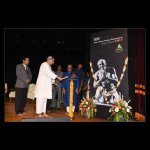

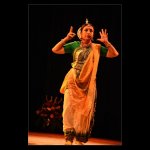
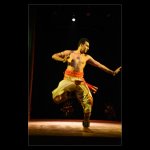
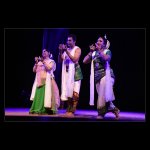
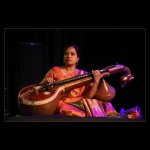
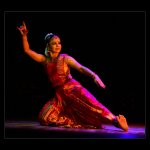
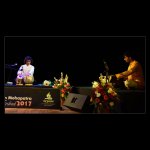
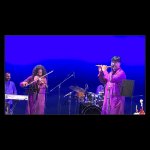
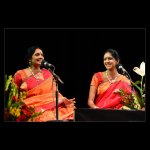
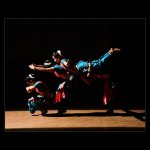
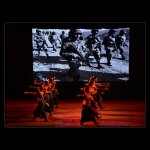
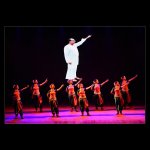
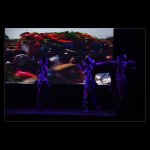
Lalitha Venkat is the content editor of www.narthaki.com |